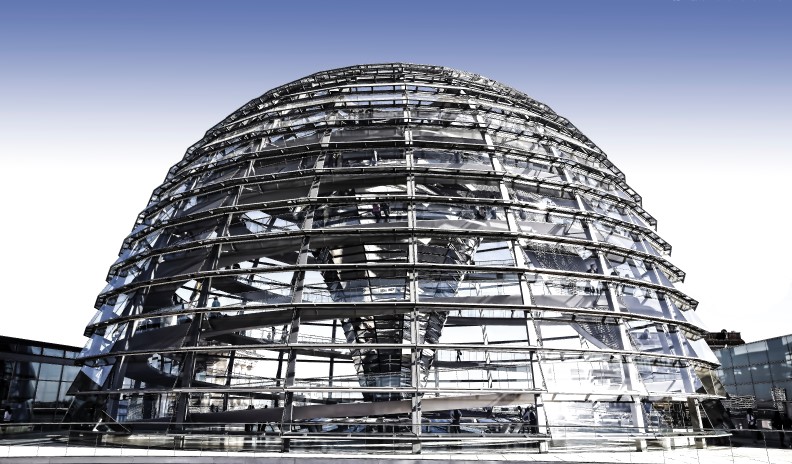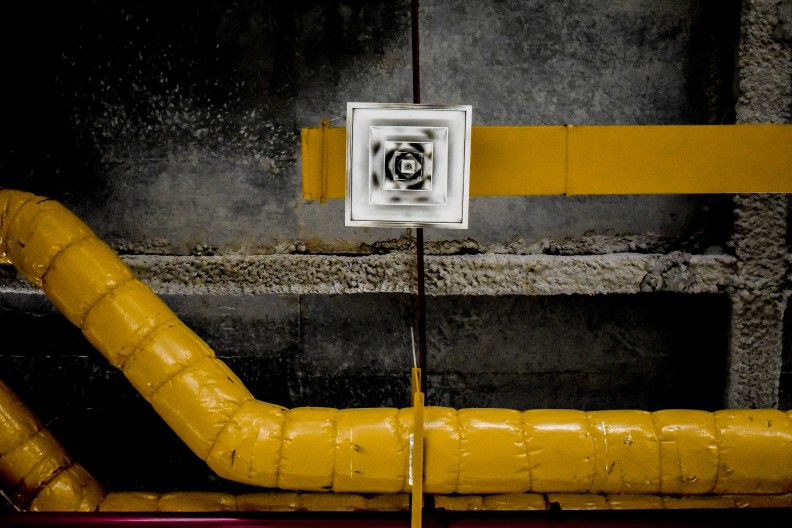How different is air quality in a normal building VS a green building?

Every human adult breathes more than 3,000 gallons (11,000 litres) of air every day, this is the equivalent of swallowing 3,000 1 gallon water bottles a day. People wouldn’t drink water that is contaminated, hence we have control systems to ensure the water we drink is safe. Still, if you suspected that the water you are about to drink is not 100% safe, you wouldn’t drink it.
What happens if the air we breathe is polluted?
Breathing happens involuntarily, and you can’t live beyond a few minutes without breathing, let alone a few days as it happens with drinking water. Therefore controlling air quality, and specifically indoor air quality is of the greatest importance to every human being.
In this article we will show you the differences between the air quality inside a normal building and a green one.
Regardless of the type of building, local building codes establish the minimum requirements to conserve indoor air quality, which are required by law. These codes are normally based on internationally recognized standards, such as those from ASHRAE. However, green buildings are held to higher design standards, offering improved performance in many aspects. This includes indoor air quality.
The concept of green buildings is very broad, since there are many design features that reduce the environmental and social impact of construction projects. However, for the purposes of this article, we will refer to buildings that meet the requirements of LEED – the most popular green building certification worldwide. A green building that is designed according to all the air quality guidelines from LEED offers the following advantages, compared with a normal building that only meets local codes:
- Additional measures to improve air quality, which are not required by codes.
- Low-emitting materials that reduce air pollution at the source.
- Air quality monitoring and control, to keep air pollutants below the thresholds recommended by LEED.
What Is a Green Building? Importance of Defining the Concept
According to the World Green Building Council, a green building is “a building that, in its design, construction or operation, reduces or eliminates negative impacts, and can create positive impacts, on our climate and natural environment. Green buildings preserve precious natural resources and improve our quality of life.”

Some ventilation measures aimed at reducing energy consumption, negatively affect air quality.
Still the term “green building” is often used to simply define a building with energy efficiency measures. Green building certifications like LEED are important, since they ensure a minimum performance level for several aspects of the building, including indoor air quality.
It is important to note that some energy efficiency measures have a detrimental effect on air quality if their implementation focuses only on saving energy. For example, a reduced ventilation rate saves energy simply because fan motors are working less. However, if this measure allows the accumulation of air pollutants, air quality will be affected negatively. These issues are avoided in a certified green building, since there are design guidelines for both air quality and energy efficiency.
A study by the University of Pittsburgh found that ventilation efficiency measures have a negative effect on air quality when they are deployed without adequate control systems.
- The study analyzed the concentration of key air pollutants like ozone, carbon monoxide, volatile organic compounds and particulate matter.
- Fan-based ventilation with automatic controls improves indoor environmental quality.
- However, green building strategies such as natural ventilation can let pollutants accumulate above the ASHRAE recommended levels when they lack effective controls.
Therefore, a normal building that features some energy saving systems without a proper control system like Foobot’s, might be posing a risk to indoor air quality.
A green building that is certified under LEED or another rating system must meet minimum design requirements for air quality. This ensures that energy efficiency improvements are not compromising indoor environmental quality.
Air Quality Requirements for a Green Building
A green building with LEED certification has been evaluated under eight performance categories, achieving a minimum score of 40. There are also Silver, Gold and Platinum certifications for earning respective minimum scores of 50, 60 and 80.

Green building strategies, like opening the windows, can let pollutants accumulate if they are not properly controlled.
Air quality requirements are covered under a category called Indoor Environmental Quality (IEQ), where the building can earn up to 16 points (8 correspond to indoor air quality, IAQ, measures). As a result, a LEED green building with many points under the IEQ category will tend to have an excellent indoor air quality.
Nevertheless not all the IAQ points are required in order to get the LEED certification.
There are two mandatory requirements that apply for all LEED buildings regardless of the score obtained, which guarantee a minimum level of air quality:
- Meeting the ventilation requirements of local building codes or ASHRAE 62.1-2010, whichever is more demanding. This ensures a green building certified under LEED will have at least the same ventilation performance as normal buildings.
- The LEED certification also requires a strict no-smoking policy. The building owner must prohibit smoking in all indoor spaces, and also outdoor areas within 25 feet of doors, windows and ventilation intakes.
From the above it can be concluded that, at least, the indoor air quality of a green LEED-certified building will be better than a normal one because it will be free from firsthand and second-hand tobacco smoke. This in fact means removing an important source of arsenic and other carcinogenic compounds from the indoor environment, though not completely due to thirdhand smoke.
LEED green buildings also have optional air quality features, which help earn 8 points towards the 40 required for certification. They are optional features because building owners can choose to earn points under other performance categories. However, a project with the 8 air quality points has much higher air quality than a normal code-compliant building, or even a LEED building with only the basic air quality features.
Optional AIQ categories:
Enhanced indoor air quality strategies are design features that exceed local codes, and that are aimed at further improving indoor air quality. The main air quality features are summarized below:
- Entryway systems that keep dirt and other particles out of the building.
- In spaces where hazardous gases are released, the exhaust system must provide enough airflow to keep pollutants out of adjacent spaces.
- Filters for all outdoor air supplies: They must be at least MERV 13 under ASHRAE standards (USA), or Class F7 under CEN standards (European).
- A ventilation design that keeps air pollutants below the levels established by the National Ambient Air Quality Standards (NAAQS). Other standards are accepted if they are more stringent than NAAQS.
- A ventilation design that provides 30% more airflow with respect to local codes or ASHRAE 62.1-2010.
- Carbon dioxide monitors according to ASHRAE 62.1 setpoints, with automatic alarms when the CO2 concentration increases by at least 10%.
Using low-emitting materials is an effective way to cut air pollution at the source, and LEED also gives points if a green building follows this strategy. This requirement is normally absent in construction codes, which means that normal buildings often use materials with a high VOC content.
The US Green Building Council created a testing procedure for seven categories of common construction materials, and points can be earned for using certified low-emitting products. The categories covered are the following:
- Interior paints and coatings
- Interior adhesives and sealants
- Flooring
- Composite wood
- Ceilings, walls, thermal and acoustic insulation
- Furniture
- Exterior applied products
A construction indoor air quality management plan only applies when a building is occupied before completing construction, or when a renovation is carried out in an occupied building. LEED provides several guidelines on how to minimize air pollution during the construction process, protecting construction workers and building occupants.
Indoor air quality assessment consists of monitoring air pollutants in a green building, and keeping them under certain threshold values. Normally, construction codes only require carbon dioxide monitoring, which means these key pollutants are not controlled in a normal building:
Contaminant | Concentration Limit |
Coarse particulate matter (PM 10) | 20 micrograms per cubic meter |
Fine particulate matter (PM 2.5) | 15 micrograms per cubic meter |
Ozone | 0.075 parts per million |
Carbon monoxide (CO) | 9 parts per million |
Total volatile organic compounds (TVOC) | 500 micrograms per cubic meter |
Formaldehyde | 27 parts per billion |
Particulate matter (PM) is a general term for a mixture of particles and liquid droplets that are typically found together, which includes dirt, dust, smoke and soot, and even microplastics. Particles with a size of less than 10 micrometers (PM 10) are generally the most harmful, since they can be inhaled and may even reach the bloodstream.
Ozone has plenty of harmful effects at ground level, especially if found in occupied spaces. It may cause shortness of breath and pain, and respiratory tract inflammation.
Carbon monoxide is an odorless, colorless and tasteless gas that is impossible to detect with human senses alone. Unlike carbon dioxide, this gas causes life-threaning reactions at much lower concentrations.
VOC’s are volatile organic compounds. These are chemical pollutants that can evaporate at room temperature. There are thousands of them, with varying effects on human health. They come from many different sources like construction material, furniture or office products. Some of the most common are Trichloroethylene, Benzene , and Xylene.
Formaldehyde is another VOC which has reached a level of enough notoriety as to be measured separately from other VOC’s.
These harmful substances are polluting the indoor air in most normal buildings since they are not being monitored nor controlled.
Are Green Buildings More Expensive than Normal Buildings?
There is a common idea that green buildings are more expensive than normal buildings. However, the long-term savings achieved by a green building are far greater than the additional upfront cost.
33 LEED buildings were analyzed during two studies conducted by Kats, G.H. for California’s Sustainable Building Task Force and the Massachusetts Technology Collaborative (2003). The studies found that green buildings are only 2% more expensive than normal buildings, but their total lifetime costs are 20% lower.
A green building that is certified under LEED or another rating system must meet minimum design requirements for air quality. This ensures that energy efficiency improvements are not compromising indoor environmental quality.
A similar study by the University of Auckland and Ade Consultants analyzed 17 buildings with the Green Star NZ certification, which is similar to LEED and developed by the New Zealand Green Building Council.
- When the cost of these buildings was compared with official construction cost data for New Zealand, they were more expensive on average, but the difference was not statistically significant.
- Some green buildings had a cost difference of less than 1%, with respect to the average construction costs in the official data.
These results contrast with a survey from Deloitte, where construction professionals were asked about their perception of green building costs. Most respondents answered that green buildings are 6% to 10% more expensive than normal ones. In other words, green buildings are more expensive on average, but their extra cost tends to be overestimated.
Conclusion
A LEED green building meets the same air quality requirements as a normal building, and it is also free of tobacco smoke, even when local codes do not require it. The LEED certification also ensures that building ventilation systems meet at least the 2010 edition of ASHRAE 62.1, even in places where local codes have lagged behind.
Thus, just the simplest version of a certified green building provides better air quality than a normal building.
Even better air quality can be expected in a LEED green building that has earned all or some of the optional air quality points. Such a building has enhanced air quality features that are not required by codes, low-emission construction materials, and air pollution monitoring and control.
Green buildings are associated with higher construction costs, but in many cases the extra cost is less than 2% compared with a normal building. However, the savings over the service life of a green building can be 20% higher than those of a normal building.
Better indoor air quality and energy usage should not be limited to certified green buildings, and actually they are not. Any building can improve its indoor air quality while saving energy in a matter of days, and without having to go through any sort of renovation, thanks to Foobot Smart Air Building. Click the button below to learn more.

Indoor comfort and energy savings on autopilot
Thermal comfort and indoor air quality are very correlated to staff health and cognitive performance, studies say.
Since human resources are businesses’ largest expense, it’s time to give them the best.